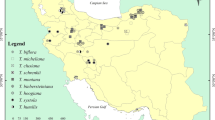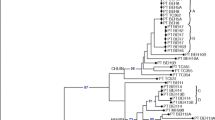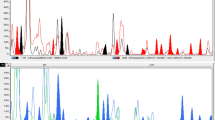Abstract
Amplified Fragment Length Polymorphisms (AFLPs) were employed within the taxonomically difficult Solanum nigrum L. complex in order to characterize the genetic diversity present in a collection of the Gatersleben Genebank, to classify taxonomically unknown material, and to correlate the clustering of the examined accessions with their geographic origin. The results from AFLP analyses using two primer combinations on 44 entries from five species led to the detection of four major clusters, simultaneously uncovering significant differences in the levels of genetic diversity within or between species. S. americanumexhibited the highest infraspecific variation despite close geographic origins, simultaneously being placed in a clearly separated cluster in comparison to the other examined species of the complex. In addition, these other species showed even less interspecific variation than was found at the infraspecific level in S. americanum. In terms of taxonomy, the application of AFLPs helped in the classification of 13 black nightshade accessions formerly only listed as Solanum sp. This also was confirmed by morphological determination. Furthermore, one accession formerly classified as S. physalifolium var. nitidibaccatum i) clustered with AFLPs and ii) was identified morphologically as S. villosum. Contradictory classifications remain for two further entries from the same species, found within the S. nigrum cluster after AFLP analyses, while belonging to S. physalifolium var. nitidibaccatum according to herbarium specimen. Finally, as indicated by the information on provenance in geographically separated subclusters in S. americanum and partially in S. villosum, clues on the currently unknown origin of accessions from the genebank seem feasible by AFLP data.
Similar content being viewed by others
References
Belaj A., Trujillo I., de la Rosa R., Rallo L. and Gimenez M.J. 2001. Polymorphism and discrimination capacity of randomly amplified polymorphic markers in an olive germplasm bank. J. Am. Soc. Hortic. Sci.126: 64–71.
Caicedo A.L., Gaitan E., Duque M.C., Chica O.T., Debouck D.G. and Tohme J. 1999. AFLP fingerprinting of Phaseolus lunatus L. and related wild species from South America. Crop Sci. 39: 1497–1507.
Colon L.T., Eijlander R., Budding D.J., van Ijzendoorn M.T., Pieters M.M.J. and Hoogendoorn J. 1993. Resistance to potato late blight (Phytophthora infestans (Mont.) de Bary) in Solanum nigrum, S. villosum and their sexual hybrids with S. tuberosum and S. demissum. Euphytica 66: 55–64.
Dehmer K.J. and Stracke S. 1999. Molecular analyses of genebank accessions of the Solanum nigrum complex. In: Andrews S., Leslie A.C. and Alexander C. (eds), Third International Sym-posium on the Taxonomy of Cultivated Plants. Royal Botanic Gardens. Royal Botanic Gardens, Kew, pp. 343–345.
Dehmer K.J. 2001. Conclusions on the taxonomy of the Solanum nigrum complex by molecular analyses of IPK germplasm accessions. In: Van den Berg R.G., Barendse G.W.M., van der Weerden G.M. and Mariani C. (eds), Solanaceae Vth: Advances in taxonomy and utilization. Proceedings of the Vth International Solanaceae Conference, July 23–29 Nijmegen. Nijmegen University Press, pp. 85–96.
Dice L.R. 1945. Measures of the amount of ecological associa-tions between species. Ecology 26: 297–302.
Doyle J.J. and Doyle J.L. 1990. Isolation of plant DNA from fresh tissue. Focus 12: 13–15.
Edmonds J.M. and Chweya J.A. 1997. 15. Black Nightshades. Solanum nigrum L. and related species. In: Heller J., Engels J. and Hammer K. (eds), Promoting the conservation and use of underutilized and neglected crops. Institute of Plant Genetics and Crop Plant Research, Gatersleben / International Plant Ge-netic Resources Institute. Rome, Italy.
Edmonds J.M. 1972. A synopsis of the taxonomy of Solanum sect. Solanum (Maurella) in South America. Kew Bulletin 27: 95–114.
Hammer K. 1986. Solanaceae. In: Schultze-Motel J. (ed.), Rudolf Mansfelds Kulturpflanzenverzeichnis. Akademie-Verlag, Berlin, pp. 1179–1223.
Hammer K., Esquivel M. and Knüpffer H. (eds), 1992. ‘... y tienen faxones y fabas muy diversos de los nuestros...’ Origin, Evolution and Diversity of Cuban Plant Genetic Resources, Vol. 2. IPK Gatersleben, pp. 213–454.
Hill M., Witsenboer H., Zabeau M. and Vos P. 1996. PCR-based fingerprinting using AFLPs as a tool for studying genetic relationships in Lactuca spp. Theor. Appl. Genet. 93: 1202–1210.
Hokanson S.C., Lamboy W.F., Szewc-McFadden A.K. and McFer-son J.R. 2001. Microsatellite (SSR) variation in a collection of Malus (apple) species and hybrids. Euphytica 118: 281–294.
Kardolus J.P., van Eck H.J. and van den Berg R.G. 1998. The potential of AFLPs in biosystematics. a first application in Solanum taxonomy (Solanaceae). Pl. Syst. Evol. 210: 87–103.
Koopman W.J.M., Zevenbergen M.J. and Van den Berg R.G. 2001. Species relationships in Lactucas.l. (Lactuceae, Asteraceae) inferred from AFLP fingerprints. Am. J. Bot. 88: 1881–1887.
Loridon K., Cournoyer B., Goubely C., Depeiges A. and Picard G. 1998. Length polymorphism and allele structure of trinucleotide microsatellites in natural accessions of Arabidopsis thaliana. Theor. Appl. Genet. 97: 591–604.
Mace E.S., Gebhardt C.G. and Lester R.N. 1999. AFLP analysis of genetic relationships in the tribe Datureae (Solanaceae). Theor. Appl. Genet. 99: 634–641.
Miyashita N.T., Kawabe A. and Innan H. 1999. DNA variation in the wild plant Arabidopsis thaliana revealed by amplified fragment length polymorphism analysis. Genetics 152: 1723–1731.
Rao G.R. and Tandon S.L. 1974. Solanum nigrum L. In: Hutchinson J. (ed.), Evolutionary studies in world crops. Cambridge University Press, London, pp. 109–117.
Ren N. and Timko M.P. 2001. AFLP analysis of genetic poly-morphism and evolutionary relationships among cultivated and wild Nicotiana species. Genome 44: 559–571.
Sefc K.M., Lopes M.S., Lefort F., Botta R., Roubelakis-Angelakis K.A., Ibanez J. et al. 2000. Microsatellite variability in grapevine cultivars from different European regions and evalua-tion of assignment testing to assess the geographic origin of cultivars. Theor. Appl. Genet. 100: 498–505.
Seithe A. 1962. Die Haararten der Gattung Solanum L. und ihre taxonomische Verwertung. Bot. Jahr. 81: 261–336.
Sharma S.K., Knox M.R. and Ellis T.H.N. 1996. AFLP analysis of the diversity and phylogeny of Lens and its comparison with RAPD analysis. Theor. Appl. Genet. 93: 751–758.
Spooner D.M., Douches D.S. and Contreras A. 1992. Allozyme variation within Solanum sect. Petota, ser. Etuberosa (Solanaceae). Am. J. Bot. 79: 467–471.
Stracke S., Njoroge G. and Hammer K. 1996. Genetic diversity in the collection of Solanum nigrum L. in the Gatersleben Genebank. In: Begemann F., Ehling C. and Falge R. (eds), Vergleichende Aspekte der Nutzung und Erhaltung pflanzen-und tiergenetischer Ressourcen (Schriften zu Genetischen Re-ssourcen, 5). IGR/ZADI, Bonn, pp. 320–324.
Swofford D.L., 1998. PAUP*. Phylogenetic Analysis Using Par-simony (*and other methods). Version 4j Sinauer Associates, Sunderland, Massachusetts USA.
Van de Wouw M., Maxted N., Chabane K. and Ford-Lloyd B.V. 2001. Molecular taxonomy of Vicia ser. Vicia based on Am-plified Fragment Length Polymorphisms. Pl. Syst. Evol. 229: 91–105.
Van den Berg R.G., Bryan G.J., del Rio A. and Spooner D.M. 2002. Reduction of species in the wild potato Solanum section Petota series Longipedicellata. AFLP, RAPD and chloroplast SSR data. Theor.Appl.Genet. 105: 1109–1114.
Venkateswarlu J. and Rao M.K. 1972. Breeding systems, cros-sability relationships and isolating mechanisms in the Solanum nigrum complex. Cytologia 37: 317–326.
Waycott W. and Ford S.B. 1994. Differentiation of nearly identical germplasm accessions by a combination of molecular and morphological analyses. Genome 37: 577–583.
Yoon M.S., Doi K., Kaga A., Tomooka N. and Vaughan D.A. 2000. Analysis of the genetic diversity in the Vigna minima complex and related species in East Asia. J. Plant Res. 113: 375–386.
Zhu J., Gale M.D., Quarrie S., Jackson M.T. and Bryan G.J. 1998. AFLP markers for the study of rice biodiversity. Theor. Appl. Genet. 96: 602–611.
Author information
Authors and Affiliations
Rights and permissions
About this article
Cite this article
Dehmer, K.J., Hammer, K. Taxonomic status and geographic provenance of germplasm accessions in the Solanum nigrum L. complex: AFLP data. Genetic Resources and Crop Evolution 51, 551–558 (2004). https://doi.org/10.1023/B:GRES.0000024163.86762.fc
Issue Date:
DOI: https://doi.org/10.1023/B:GRES.0000024163.86762.fc




